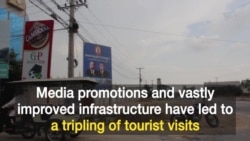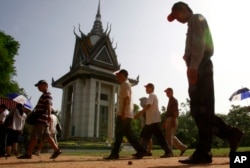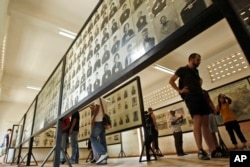The number of tourists visiting Cambodia’s genocide sites has more than tripled during the last 10 years, raising concerns that commercialism is compromising efforts to preserve memorials for 2 million people who perished here under Pol Pot and his Khmer Rouge.
Chhour Sokty, director at Choeung Ek, the best known of the sites commonly called The Killing Fields, said visitor numbers had leaped to as many as 800 a day since he began working here 11 years ago, with media promotions leading to increased numbers of tourists, who are helped by vastly improved roads and amenities like public toilets.
“I was in charge here in 2005 when there were only about 100 to 200, or a maximum 300 visitors per day. But now it is about 700 to 800 per day during high season,” he said.
Watch: Tourism at Cambodia's Genocide Sites Raise Concern
Genocide tourism
Each day at Choeung Ek, 17 kilometers south of Phnom Penh, tourists arrive by tuk-tuk (three-wheeled taxi), motorbike and air-conditioned coaches.
The attraction is macabre; skulls stacked neatly in a stupa (dome-shaped monument) surrounded by mass graves where thousands were bludgeoned to death, usually with an ox-cart axle, and buried — all victims of the 1975-1979 mass killings by Pol Pot’s henchmen.
“Most people from around the world have heard about that black period in Cambodia, which killed almost 2 million people,” said Kob Kalyaney who works for a private tour agency.
“Tourists want to learn if the history is real and they want to witness it,” she said.
There are hundreds of sites across Cambodia like Choeung Ek. The difference is that here, and at the S-21 extermination camp in Phnom Penh, admission is charged, bringing in a tidy income. Booksellers, street vendors, tuk-tuk drivers, tour companies and beggars all do a brisk trade.
Leaving a mark
And too many tourists have left their mark.
Some scribble graffiti on prison walls at S-21, site of the Tuol Sleng Genocide Museum where Pol Pot’s victims were processed before being sent to the Killing Fields. Buildings, prison cells and grisly displays of paintings and photographs, along with instruments of torture, have been displayed for daily crowds.
At Choeung Ek, some innocently tie ribbons and notes to the mass graves, but others collect bone fragments, smoke and eat on the steps of the bone-filled stupa and ignore rules regarding the use of cameras and silence.
Youk Chhang, executive director of the Documentation Center of Cambodia (DC-Cam), said Western tourists arrived here with an abstract mindset that avoids unnecessary displays of violence while Asian visitors expect to see blood and graphic evidence of what happened.
He said it was a mix that needed to be catered to, but stressed that neither Choeung Ek nor the S-21 site in Phnom Penh, a former school, were businesses run for profit.
“We should preserve for our children not for the tourists. But tourists are welcome if they want to visit, if they want to see it, they want to understand it, they’re welcome. That’s the whole purpose of the preservation of the site,” he said.
He said a lack of information was partly to blame for inappropriate behavior and that tourists were not aware of the rules and recently introduced regulations. But he added that photos of Khmer Rouge leaders on the exhibition walls of Choeung Ek were often replaced because of graffiti.
“People get so upset when they see the photograph of the Khmer Rouge leaders so they write on it. ... I think that it can be bad, it can be good,” he said. “You cannot stop people from being, feeling upset.”
Evidence and a sanctuary
The bones at Choeung Ek and the remnants of S-21, like all the other Killing Fields sites, are evidence and crime sites for the Khmer Rouge Tribunal, which has spent the last decade prosecuting Pol Pot’s surviving lieutenants, securing three convictions for crimes against humanity.
Currently two former leaders, Nuon Chea and Khieu Samphan, are on trial for genocide, while further cases involving lower ranking cadre are pending and could last another five years.
A quiet debate over what to do with the remains of so many people once the tribunal is finished persists. Many people believe the bones should be cremated according to Buddhist tradition, while others say the sites should be kept as they are.
“It’s our memory, it should be preserved the way it is; historically and with respect to our culture, rather than try to create something to attract tourists that’s leading to commercializing the memory, which is something that you do not want to do,” Youk Chhang said.
New and improved
DC-Cam has backed a proposed genocide center, the Sleuk Rith Institute, a $40 million construction of five towers in Phnom Penh, rising out of a surrounding forest and designed by London-based Zaha Hadid Architects.
It will become the permanent home of the largest collection of genocide-related material in Southeast Asia, archived by DC-Cam.
That would complement the original sites where atrocities were committed.
Youk Chhang said the raw, original state of the prison, when it boasted a large wall map of Cambodia made of human skulls, was far more profound than the current day experience.
“You know in the ’80s or in the ’90s it is as it is, it’s extremely powerful, very effective. And that itself also creates a feeling … it forces people to show some respect, because it is so original,” he said.
S-21 and Choeung Ek have been rebranded as museums, but Youk Chhang said facilities need to be improved further, and that might include a guest book in each room at S-21, or a white board and a space where people can think and write about their experiences.
But any change would be limited and any major work delayed until after the Khmer Rouge Tribunal has finished its work.
Youk Chhang’s sentiments were echoed by Khoeun Somrach, a middle-aged tuk-tuk driver who works from S-21 and first came here in 1980 when the floors were still covered in blood and the remains of those tortured to death inside the camp were scattered between class rooms.
“Before, it was really quiet, we only had nationals coming to visit but now there are many foreigners,” he said, adding the grounds around S-21 need an upgrade. “We should preserve the evidence but the place needs to be cleaned.”
Luke Hunt contributed to this report.












